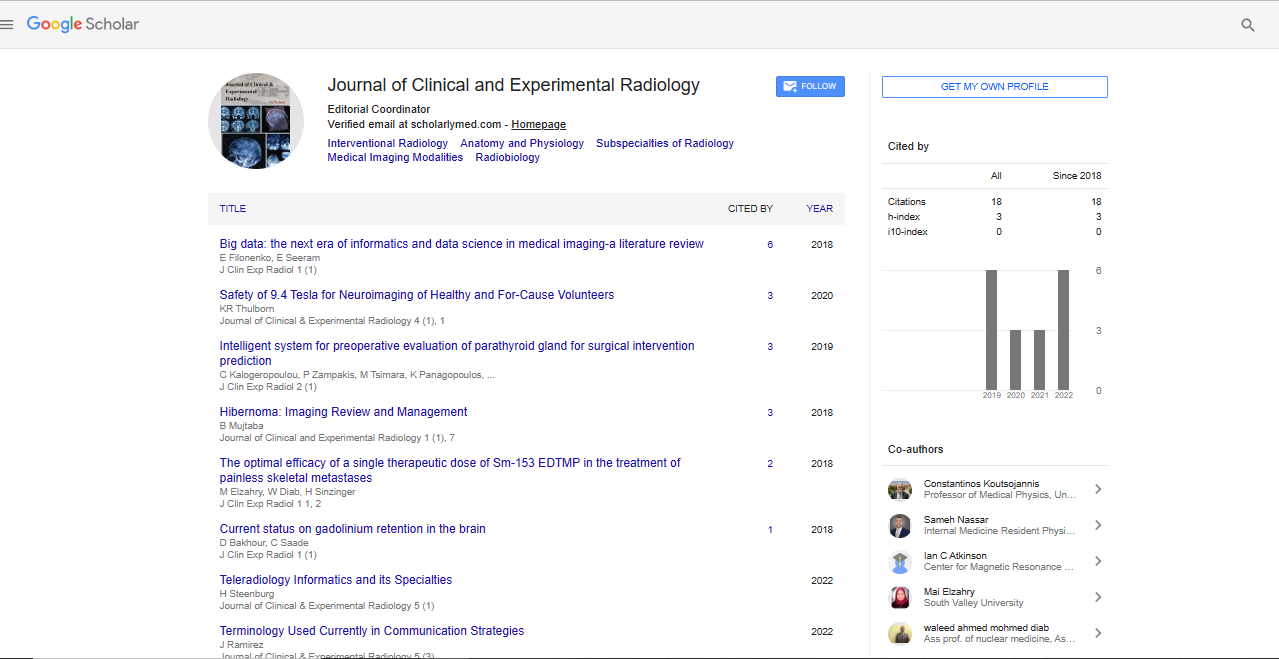Opinion Article, Vol: 6 Issue: 2
Radiopharmaceutical Production and Quality Control in Nuclear Medicine
Varela Melone*
1Department of Oral and Maxillofacial Surgery, Central University Hospital of Asturias, Oviedo, Spain
*Corresponding Author: Michael Williams,
Department of Oral and Maxillofacial
Surgery, Central University Hospital of Asturias, Oviedo, Spain
E-mail: varela_melone@yahoo.com
Received date: 30 August, 2023, Manuscript No. JCER-23-116674;
Editor assigned date: 01 September, 2023, PreQC No. JCER-23-116674 (PQ);
Reviewed date: 15 September, 2023, QC No. JCER-23-116674;
Revised date: 22 September, 2023, Manuscript No. JCER-23-116674 (R);
Published date: 29 September, 2023, DOI: 10.4172/jcer.1000146
Citation: Melone V (2023) Radiopharmaceutical Production and Quality Control in Nuclear Medicine. J Clin Exp Radiol 6:3.
Description
Nuclear medicine is a medical specialty that employs radioactive materials, known as radiopharmaceuticals, to diagnose and treat a wide range of medical conditions. Radiopharmaceuticals are unique in that they combine pharmaceuticals with radioactive isotopes, allowing for the visualization and measurement of physiological processes within the body. The production and quality control of radiopharmaceuticals are critical aspects of nuclear medicine, ensuring that patients receive accurate diagnoses and effective treatments while minimizing radiation exposure. This essay explores the process of radiopharmaceutical production and the rigorous quality control measures that are integral to the field of nuclear medicine.
Radiopharmaceuticals are chemical compounds that contain a radioactive isotope, or radionuclide, and a biologically active molecule. These compounds are designed to selectively accumulate in target tissues or organs, depending on the medical purpose. Radiopharmaceutical production begins with the selection of an appropriate radionuclide. The choice of radionuclide is based on the half-life, decay characteristics, and the specific medical application. Commonly used radionuclides include Technetium-99m (Tc-99m), Iodine-131 (I-131), and Fluorine-18 (F-18). The radiopharmaceuticals themselves are prepared by combining the chosen radionuclide with a biologically active molecule. This can be done through various methods, such as radiolabeling with a precursor molecule or direct irradiation of the target compound. The resulting radiopharmaceutical should be stable and exhibit minimal chemical and biological side effects. The production process must adhere to strict regulatory guidelines, including Good Manufacturing Practices (GMP), to ensure patient safety.
Quality control in radiopharmaceutical production
Quality control is a vital aspect of radiopharmaceutical production in nuclear medicine. Rigorous quality control measures are essential to guarantee the safety, efficacy, and accuracy of radiopharmaceuticals used in diagnosis and treatment. These measures encompass several key aspects:
Radionuclide purity: The radionuclide used must be highly pure, as impurities can affect the diagnostic or therapeutic efficacy of the radiopharmaceutical. This requires precise measurement and validation of the radionuclide's purity using techniques like gamma spectroscopy.
Radiochemical purity: The radiopharmaceutical must have a high degree of radiochemical purity, meaning that the radionuclide is correctly incorporated into the desired compound. This is assessed through radiochromatography and other analytical techniques.
Chemical purity: The chemical purity of the radiopharmaceutical is essential to prevent unwanted side effects. Residual precursor compounds, by-products, or impurities should be minimal and within acceptable limits.
Sterility: Radiopharmaceuticals must be sterile to prevent infections in patients. Sterility testing, using methods such as the membrane filtration test or direct inoculation, is carried out to confirm the absence of microbial contamination.
Specific activity: The specific activity of a radiopharmaceutical is the radioactivity per unit mass. This parameter is crucial to ensure that the administered dose is therapeutically effective or provides accurate diagnostic information.
Radiation dose: Radiopharmaceuticals used in nuclear medicine should deliver the appropriate radiation dose to the target tissue while minimizing exposure to healthy tissues. Dosimetry calculations are performed to optimize this balance.
Stability: Radiopharmaceuticals must have sufficient stability to remain effective during storage and administration. Stability testing is essential to determine shelf life and storage conditions.
Quality control procedures in radiopharmaceutical production involve rigorous testing at each stage, from raw materials to the final product. These measures ensure that the radiopharmaceuticals meet the required specifications and comply with regulatory standards. Any deviations from these standards can lead to unreliable results, inadequate treatment, or potential harm to patients. Radiopharmaceuticals play a crucial role in nuclear medicine, with a wide range of diagnostic and therapeutic applications. Diagnostic applications include Single-Photon Emission Computed Tomography (SPECT) and Positron Emission Tomography (PET) scans, which use radiopharmaceuticals to visualize organ function, detect tumors, and assess blood flow and metabolism. Therapeutic applications involve the use of radiopharmaceuticals to selectively target and destroy cancer cells (radiotherapy) or abnormal thyroid tissue radioiodine therapy.
Radiopharmaceutical production and quality control are fundamental aspects of nuclear medicine, ensuring that patients receive safe and effective diagnoses and treatments. The combination of pharmaceuticals with radioactive isotopes provides a unique and powerful tool for understanding the human body's functions and addressing various medical conditions.
 Spanish
Spanish  Chinese
Chinese  Russian
Russian  German
German  French
French  Japanese
Japanese  Portuguese
Portuguese  Hindi
Hindi 